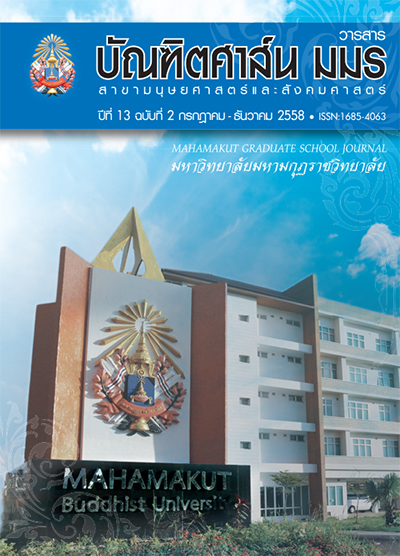Paññā (Insight) into the Phenomena of Present Momentin Vipassanā-bhāvanā
Keywords:
Insight, Phenomena, Present Moment, Vipassanā-bhāvanāAbstract
This thesis consists of three objectives: 1) tos tudy the phenomena of presentmomen tin Theravāda Buddhist Scriptures,2 )to study the practice of Vipassanā-bhāvanā in Theravāda Buddhist Scriptures, and3) to study Paññā (Insight) into the phenomena of present moment in Vipassanā-bhāvanā. The thesis is based on documentary research bystudying the Tipiṭaka, Aṭṭhakathā, Ṭīkā, as well as other related scriptures and textbooks, and presenting the findings in a descriptive narrative with subsequent verification by Buddhist scholars. The following highlights the research findings.
The phenomena of present momentare the present moment of the Five Aggregates or Rūpa-Nāma. The present moment is comprised of three kinds, namely, 1) Present by moment includes one mind-moment (Citta) reaches the three moments of arising, presence, and dissolution, as well as a thought moment (Citta Khaṇa) in a thought process (Citta Vīthi). Only the Buddha can perceive this present state of mind.2) Present by continuity, which includes Rūpa continuity consisting of 1-2 rounds of the five sense-door process and Nāma continuity consisting of 2-3 rounds of the mind-door process, this present state, the mind is only aware of the ultimate reality and clearly perceives the arising and disappearing of phenomena. And 3) Present by extent is the present moment that extents from the first two kinds.
The practice of Vipassanā-bhāvanā is divided into 4 types, namely: 1) Samatha- Pubbaṇgamam-Vipassanā-Bhāvanā, 2) Vipassanā-Pubbaṇgamam-Samādha- Bhāvanā, 3) Samatha-Vipassanā-Yuganaddha- Bhāvanā,and 4) Dhammudhacca-Viggahito- Mānassa-Bhāvanā. The observation of the present phenomena is harmonized with the second type, which is the practice of tran quil ity pre ceded by insight,specifically, ‘Vipassanā-Khaṇika-Samādhi’(Vipassanā based on momentary concentration). When the mind is steadfast, calm and free from the Five Hindrances, and becomes powerful as Upacāra Samādhi (Access Concentration), then the mind can observe Rūpa-Nāma by Lokiya-Pariññā (Three kinds of mundane full-understanding), namely, Ñāta-Pariññā (Full-understanding as the known), Tiraṇa-Pariññā (Full-understanding as investigation), and Pahāna-Pariññā (Full-understanding as abandoning).
The Paññā (Insight) into the phenomena of present momentin Vipassanā-bhāvanā will occur after observing the phenomena throughLokiya-Pariññāby abandoning all causes that hide the ultimate reality of phenomena in sequence. 1) Ñāta-Pariññā extends from the insight knowledge of the 1st Namarupapariccheda-Ñāṇa,the discrimination into mind and matter, up to the 2nd Paccayapariggaha-Ñāṇa, the knowledge of conditionality. These two Ñāṇas are the beginning of abandonselfillusion and the perception of non-self. 2) Tiraṇa-Pariññāextends from the 3rd Sammasana-Ñāṇa, the knowledge of comprehension of the Three Universal Characteristics,up to the 4th Udayabbaya -Ñana, the knowledge of arising and dissolutionas well as realizing the ten imperfections of insight. And 3) Pahāna- Pariññā extends from the 5th BhangaÑāṇa, the knowledge of dissolution,up until the 12th Anuloma-Ñāṇa, the conformity knowledge. Bhanga-Ñāṇais where a climax of perception of impermanenceis reached. The 9th Muncitukamyata-Ñāṇais where the suffering of formations reaches a peak. The 11thSankharupekkha-Ñāṇa is when the knowledge of equanimity reaching the culmination. Then Anuloma-Ñāṇawill occur and can lead to the path knowledge or Magga-Ñāṇa.
References
(1) พระไตรปิฎก:
มหาจุฬาลงกรณราชวิทยาลัย. พระไตรปิฎกภาษาไทยฉบับมหาจุฬาลงกรณราชวิทยาลัย เล่มที่ 29 ,17 ,14 ,12, 31. กรุงเทพมหานคร: โรงพิมพ์มหาจุฬาลงกรณราชวิทยาลัย, 2539.
มหามกุฏราชวิทยาลัย. พระไตรปิฎกพร้อมอรรถกถาแปล เล่มที่ 76, 68, 69. กรุงเทพมหานคร: โรงพิมพ์มหามกุฏ ราชวิทยาลัย, 2527.
(2) ฎีกา และปกรณ์วิเสส: พระพุทธโฆสเถระ. คัมภีร์วิสุทธิมรรค. แปลและเรียบเรียงโดยสมเด็จพระพุฒาจารย์ (อาจ อาสภมหาเถร). พิมพ์ครั้งที่ 7. กรุงเทพมหานคร: บริษัท ธนาเพรส จํากัด, 2551.
พระอนุรุทธะและพระญาณธชนะ. อภิธัมมัตถสังคหะและปรมัตถทีปนี, แปลโดยพระคันธสาราภิวงศ์.พิมพ์ครั้งที่ 3. กรุงเทพมหานคร: ห้างหุ้นส่วนจํากัด ประยูรสาส์นไทยการพิมพ์, 2552.
ข. ข้อมูลทุติยภูมิ
(1) หนังสือ:
พระเทพมุนี (วิลาศ ญาณวโร ป.ธ. 9). วรรณกรรมไทยเรื่องกรรมทีปนี. กรุงเทพมหานคร: โรงพิมพ์รุ่งเรืองธรรม, 2527.
สมเด็จพระญาณสังวร สมเด็จพระสังฆราช สกลมหาสังฆปริณายก. การปฏิบัติกรรมฐาน. พิมพ์ครั้งที่ 4. กรุงเทพมหานคร: โรงพิมพ์มหามกุฏราชวิทยาลัย, 2551.
_________.ธรรมาภิธาน. กรุงเทพมหานคร:บริษัท อัมรินทร์พริ้นติ้งแอนด์พับลิชชิ่ง จํากัด (มหาชน). 2552.
พระพรหมคุณาภรณ์ (ป.อ.ปยุตฺโต). พุทธธรรม ฉบับปรับปรุงและขยายความ.พิมพ์ครั้งที่ 12. กรุงเทพมหานคร: โรงพิมพ์มหาจุฬาลงกรณราชวิทยาลัย, 2551.
พันตรีป. หลงสมบุญ. พจนานุกรม มคธ-ไทย. กรุงเทพมหานคร: อาทรการพิมพ์, 2540.
พระโสภณมหาเถระ (มหาสีสยาดอ).วิปัสสนาชุนี หลักการปฏิบัติวิปัสสนา (ฉบับสมบูรณ์). แปลโดยจํารูญ ธรรมดา. กรุงเทพมหานคร:ห้างหุ้นส่วนจํากัด ประยูรสาส์นไทย การพิมพ์, 2553.
________.วิปัสสนานัย เล่ม 1. แปลและเรียบเรียงโดยพระคันธสาราภิวงศ์. กรุงเทพมหานคร:ห้างหุ้นส่วนจํากัด ประยูรสาส์นไทย การพิมพ์, 2555.
________.วัมมิกสูตร ปริศนาแห่งจอมปลวก. แปลและเรียบเรียงโดยพระคันธสาราภิวงศ์. กรุงเทพมหานคร: ห้างหุ่นส่วนจํากัด ประยูรสาส์นไทย การพิมพ์, 2558.
________.ปฏิจจสมุปบาท เหตุผลแห่งวัฏสงสาร. แปลและเรียบเรียงโดยพระคันธสาราภิวงศ์. กรุงเทพมหานคร: หจก. ประยูรสาส์นไทย การพิมพ์, 2553.
Sujiva. The Tree of Wisdom The River of No Return: The practice and development on insight meditation. Penang: Sukhi Hotu Sdn Bhd, 2009.
Downloads
Published
How to Cite
Issue
Section
License
บทความวิชาการและบทความวิจัยในวารสารฉบับนี้ถือเป็นความรับผิดชอบของผู้เขียนเท่านั้น บทความที่ได้รับการตีพิมพ์ในวารสารบัณฑิตศาส์น ถือเป็นลิขสิทธิ์ของมหาวิทยาลัยมหามกุฏราชวิทยาลัย ตามพระราชบัญญัติลิขสิทธิ์



